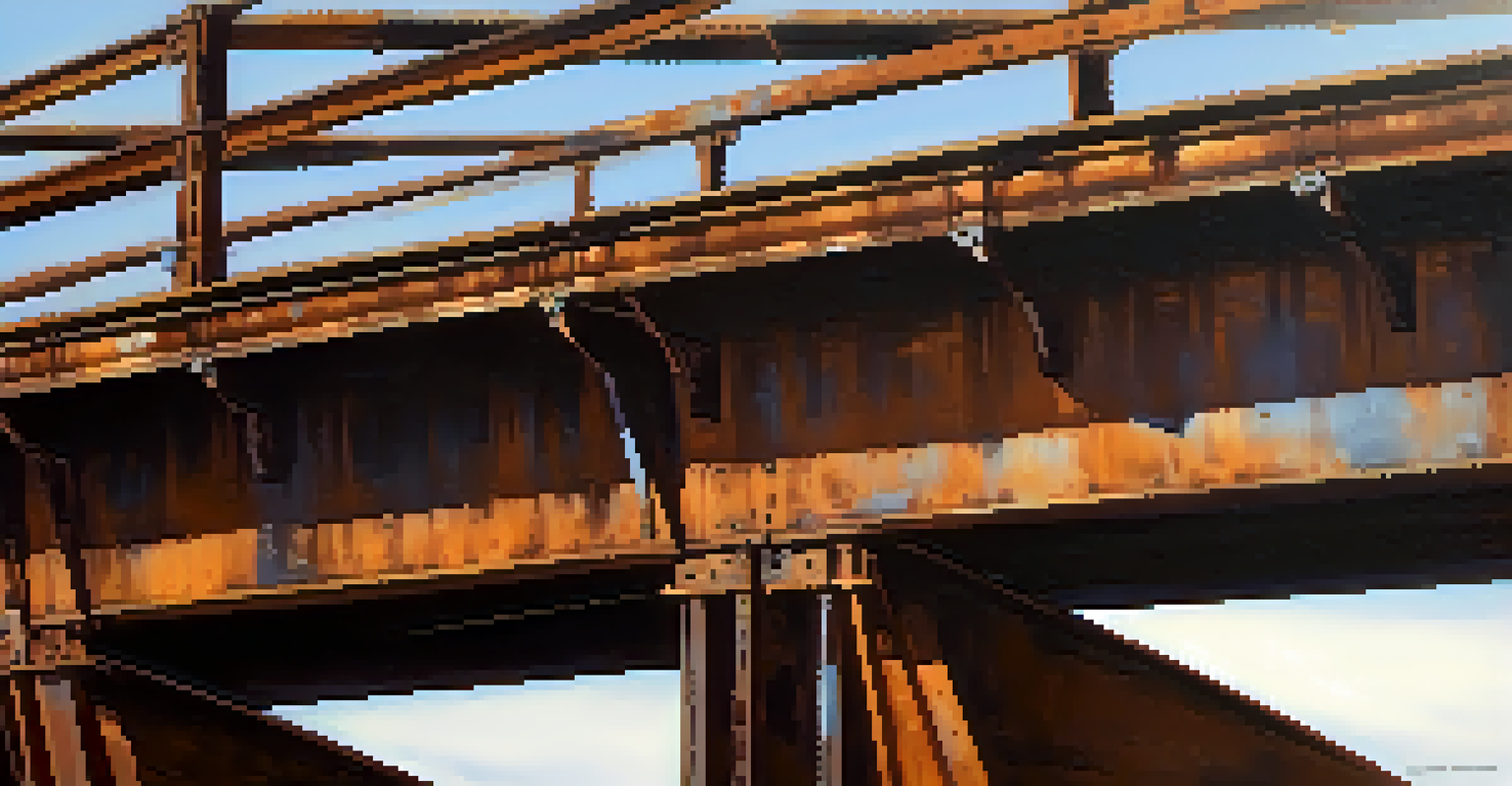Evaluating NYC's Aging Bridges: Safety and Maintenance Issues

Understanding the Importance of NYC's Bridges
New York City is famous for its iconic bridges, which are not just beautiful structures but vital connectors for millions of commuters. They facilitate the movement of people, goods, and services, making the city's economic engine run smoothly. However, many of these bridges are aging and require careful evaluation to ensure their structural integrity.
Infrastructure is the backbone of our cities, and without proper maintenance, it can crumble beneath us.
Bridges like the Brooklyn and Manhattan bridges have stood the test of time, but their age raises concerns about wear and tear. Regular assessments are crucial to identify potential safety hazards before they become serious problems. After all, a bridge’s condition can significantly impact traffic flow and safety for everyone who uses it.
Moreover, the emotional attachment many New Yorkers have to these landmarks adds another layer of urgency to maintenance discussions. Keeping these bridges in good shape is not just about safety; it’s about preserving the city’s history and ensuring that future generations can enjoy them.
Current State of NYC Bridges: An Overview
As of late 2023, many of NYC's bridges are rated in varying conditions, with some classified as structurally deficient. This term means that while the bridge is still safe for use, it requires significant repairs to maintain its function and safety. The challenge lies in balancing immediate repairs with long-term upgrades, given the city’s budget constraints.

The American Society of Civil Engineers (ASCE) has highlighted these concerns in its reports, emphasizing that a considerable portion of NYC's bridge infrastructure is aging. With an ever-increasing number of vehicles and pedestrians relying on these structures, the need for improvements has never been more pressing. It's a situation that demands a comprehensive understanding of both current conditions and future needs.
NYC Bridges Need Urgent Maintenance
Many of New York City's bridges are aging and require significant repairs to ensure safety and preserve their historical significance.
Additionally, community feedback plays a vital role in bridge assessments. Residents often notice issues before formal inspections occur, making their insights invaluable in prioritizing repairs and maintenance.
Common Safety Issues Faced by Aging Bridges
Aging bridges often exhibit a range of safety issues, including cracking, corrosion, and structural weaknesses. These problems can result from years of heavy traffic, exposure to the elements, and a lack of timely maintenance. Addressing these issues swiftly is crucial to prevent catastrophic failures that could endanger lives.
The safety of our bridges is not just an engineering issue; it’s a community concern that requires collective action and awareness.
For example, the presence of rust on steel beams can compromise the bridge's strength, leading to serious safety concerns. Similarly, concrete deterioration can result in falling debris, posing a hazard to vehicles and pedestrians alike. Each of these issues highlights the importance of regular inspections and proactive maintenance to catch problems early.
Moreover, the complexity of these structures means that repairs can be expensive and time-consuming. However, investing in maintenance today can save substantial costs in the future while ensuring public safety remains a top priority.
Challenges in Bridge Maintenance Funding
One of the primary challenges in maintaining NYC's bridges is securing adequate funding. While the need for repairs is clear, budget constraints often limit the city's ability to address these issues comprehensively. Funding for bridge maintenance frequently competes with other pressing needs, such as public transportation and housing.
Government grants and federal funding can provide some relief, but these sources are often unpredictable. The reliance on these funds means that bridge maintenance can fall victim to shifting political priorities, leading to delayed repairs. This uncertainty complicates long-term planning and leaves many bridges in a state of limbo.
Funding Challenges Impact Repairs
Securing adequate funding for bridge maintenance is a major challenge, often competing with other city needs and subject to political uncertainties.
Additionally, public awareness of these funding challenges is crucial. Encouraging community advocacy for infrastructure funding can help ensure that bridge maintenance remains a priority in local and national discussions.
Technological Advances in Bridge Inspection
In recent years, technology has played a significant role in improving bridge inspection processes. Innovative tools, such as drones and advanced imaging techniques, allow engineers to assess structures more efficiently and accurately. This technology enables inspectors to identify issues that might be missed during traditional assessments.
For instance, drones equipped with high-resolution cameras can capture detailed images of hard-to-reach areas, providing a clearer picture of a bridge’s condition. This not only speeds up the inspection process but also reduces the need for potentially hazardous scaffolding setups. The use of such technology has revolutionized how we approach bridge maintenance.
Moreover, the data collected through these advanced methods can be analyzed to predict future maintenance needs. By understanding trends in deterioration, city planners can allocate resources more effectively and prioritize repairs where they are needed most.
Case Studies: Notable Repairs and Upgrades
Several recent case studies illustrate successful repair and upgrade efforts on NYC's aging bridges. For instance, the Williamsburg Bridge underwent significant rehabilitation work that included replacing old cables and reinforcing the structure. This project not only extended the bridge's lifespan but also improved safety for commuters.
Another example is the ongoing work on the Queensboro Bridge, where engineers are implementing modern materials and techniques to address wear and tear. These upgrades are essential for accommodating the increasing traffic demands while maintaining safety standards. Such projects demonstrate the city's commitment to preserving its infrastructure.
Technology Enhances Bridge Inspections
Innovative tools like drones and advanced imaging techniques are revolutionizing bridge inspections, allowing for more efficient and accurate assessments.
These case studies highlight the importance of strategic investment in bridge maintenance. They serve as reminders that with the right planning and resources, we can ensure the continued safety and functionality of these vital structures.
The Community's Role in Bridge Safety Awareness
Community involvement is vital when it comes to maintaining the safety of NYC's bridges. Local residents often notice changes or issues before they are officially reported, making their input essential for timely interventions. Encouraging a culture of awareness can help identify potential problems early on.
Public forums and outreach programs can help educate residents about bridge safety and the signs to look out for. By fostering a sense of responsibility, communities can play an active role in advocating for maintenance and repairs. This grassroots approach ensures that the voices of those who use the bridges daily are heard.

Ultimately, a well-informed public can drive the conversation about infrastructure needs, pushing for funding and attention where it's most needed. When communities come together to prioritize bridge safety, everyone benefits.